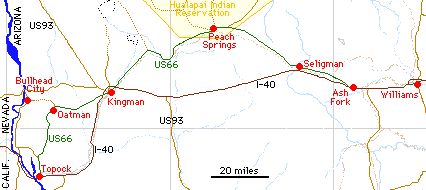Route 66
22.07.2003
|
Ten wtorek to dzień drogi. Wstaliśmy bardzo rano – przed nami ponad 600 mil do Kalifornii i Parku Sekwoi. Na początku wjechaliśmy na jeden z ostatnich tak długich zachowanych fragmentów legendarnej Routte 66, czyli drogi krajowej nr 66. Co w niej takiego legendarnego? Budowę tej drogi łączącej Chicago z Los Angeles ukończono pod koniec lat 20 ubiegłego wieku. Wczasach Wielkiego kryzysu wędrowano po niej w poszukiwaniu pracy, później, gdy Amerykanie odkryli dla siebie samochód wyprawa drogą 66 stała się głównym planem wakacyjnym wielu rodzin, to na niej pojawili się pierwsi autostopowicze i poszukiwacze przygód, to na niej miało miejsce wiele historii będących kanwą filmów (np. Bagdad Cafe), piosenek i powieści. Teraz 66 jest pusta – zastąpiła ją I40 - ożywia się tylko na czas corocznych zjazdów starych samochodów, dla których urządza się tu rajdy. Trudno też odnaleźć jej klimat – nam udało się trochę go poczuć, gdy zatrzymaliśmy się na przydrożnej stacji benzynowej. Jej właściciel był niewątpliwie fanatykiem Routte 66. Wokół znajdowało się mnóstwo pamiątek z okresu jej świetności, począwszy od starych samochodów po stare przydrożne reklamy Coca Coli… Po tym krótkim nostalgicznym przystanku ruszyliśmy dalej. Czekała na nas Kalifornia. |
Route 66, between Chicago and Los Angeles, was named in 1926 but largely replaced by the more efficient interstate system during the 60s and 70s. In the 40 years of its existence the road became the subject of countless songs, films, books and legends yet today there are few traces remaining; large cross-country sections became part of the interstates and other stretches fell into disuse. Despite this abandonment, the route is still the main street of many towns and several long parts of the original road do survive, such as through the Mojave Desert in California and a 65 mile section in New Mexico, just north of I-40 and through such small towns as Laguna, Grants and Prewitt. However, the best preserved section in the Southwest is in Arizona, between Topock on the Colorado River and Ash Fork east of Seligman - about 165 miles in total and including the main street of Kingman, the largest town on the route. Further east, another short stretch of original road runs through the centre of Williams, another historic old town. Beyond Kingman, Route 66 crosses varied landscapes of sand, forest and scrubland for over 100 miles, through several small peaceful towns en route to I-40 near Ash Fork. Further east, the original route has largely disappeared under the interstate, but it reappears briefly to form the main street of Williams. |

RoGaj 2003